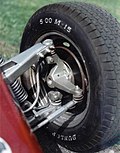Steering
Steering is the collection of components, linkages, etc. which allows any vehicle (car, bicycle, ship, aircraft, etc.) to follow the desired course. An exception is the case of rail transport by which rail tracks combined together with railroad switches (and also known as 'points' in British English) provide the steering function.
History[edit]
The term steering comes from the Old Norse word stýri, which means a part in the ship used for its direction. Steering wheels were first used in ships. With the development of technology, steering systems have evolved and are now used in cars, trucks, buses, and other land vehicles.
Types of Steering Systems[edit]
There are three main types of steering systems: manual, power, and four-wheel steering.
Manual Steering[edit]
Manual steering is the simplest and oldest type of steering. The driver uses their physical effort to turn the wheels.
Power Steering[edit]
Power steering uses a system of hydraulic or electric actuators to aid in steering. The system allows the driver to guide the vehicle with less effort than manual steering.
Four-Wheel Steering[edit]
Four-wheel steering is a system that allows the rear wheels to turn at a certain angle relative to the front wheels. This system improves maneuverability and reduces the turning radius.
Steering Components[edit]
The main components of a steering system include the steering wheel, steering column, steering gear, and steering linkage. These components work together to control the direction of the vehicle.
Steering Wheel[edit]
The steering wheel is the part of the steering system that the driver manipulates to guide the vehicle.
Steering Column[edit]
The steering column is a shaft that connects the steering wheel to the steering gear.
Steering Gear[edit]
The steering gear is a device that converts the rotational motion of the steering wheel into linear motion to turn the wheels.
Steering Linkage[edit]
The steering linkage is a system of rods, links, and arms that transmit motion from the steering gear to the wheels.
See Also[edit]
| Automobile technologies | ||||||||||
|---|---|---|---|---|---|---|---|---|---|---|
This Automobile technologies related article is a stub.
|
This vehicle dynamics related article is a stub. You can help WikiMD by expanding it.
-
Steering
-
Steering
-
Steering
-
Steering
-
Steering
-
Steering
-
Steering
-
Steering
-
Steering
-
Steering
-
Steering
-
Steering
Ad. Transform your life with W8MD's Budget GLP-1 injections from $75


W8MD offers a medical weight loss program to lose weight in Philadelphia. Our physician-supervised medical weight loss provides:
- Weight loss injections in NYC (generic and brand names):
- Zepbound / Mounjaro, Wegovy / Ozempic, Saxenda
- Most insurances accepted or discounted self-pay rates. We will obtain insurance prior authorizations if needed.
- Generic GLP1 weight loss injections from $75 for the starting dose.
- Also offer prescription weight loss medications including Phentermine, Qsymia, Diethylpropion, Contrave etc.
NYC weight loss doctor appointmentsNYC weight loss doctor appointments
Start your NYC weight loss journey today at our NYC medical weight loss and Philadelphia medical weight loss clinics.
- Call 718-946-5500 to lose weight in NYC or for medical weight loss in Philadelphia 215-676-2334.
- Tags:NYC medical weight loss, Philadelphia lose weight Zepbound NYC, Budget GLP1 weight loss injections, Wegovy Philadelphia, Wegovy NYC, Philadelphia medical weight loss, Brookly weight loss and Wegovy NYC
|
WikiMD's Wellness Encyclopedia |
| Let Food Be Thy Medicine Medicine Thy Food - Hippocrates |
Medical Disclaimer: WikiMD is not a substitute for professional medical advice. The information on WikiMD is provided as an information resource only, may be incorrect, outdated or misleading, and is not to be used or relied on for any diagnostic or treatment purposes. Please consult your health care provider before making any healthcare decisions or for guidance about a specific medical condition. WikiMD expressly disclaims responsibility, and shall have no liability, for any damages, loss, injury, or liability whatsoever suffered as a result of your reliance on the information contained in this site. By visiting this site you agree to the foregoing terms and conditions, which may from time to time be changed or supplemented by WikiMD. If you do not agree to the foregoing terms and conditions, you should not enter or use this site. See full disclaimer.
Credits:Most images are courtesy of Wikimedia commons, and templates, categories Wikipedia, licensed under CC BY SA or similar.
Translate this page: - East Asian
中文,
日本,
한국어,
South Asian
हिन्दी,
தமிழ்,
తెలుగు,
Urdu,
ಕನ್ನಡ,
Southeast Asian
Indonesian,
Vietnamese,
Thai,
မြန်မာဘာသာ,
বাংলা
European
español,
Deutsch,
français,
Greek,
português do Brasil,
polski,
română,
русский,
Nederlands,
norsk,
svenska,
suomi,
Italian
Middle Eastern & African
عربى,
Turkish,
Persian,
Hebrew,
Afrikaans,
isiZulu,
Kiswahili,
Other
Bulgarian,
Hungarian,
Czech,
Swedish,
മലയാളം,
मराठी,
ਪੰਜਾਬੀ,
ગુજરાતી,
Portuguese,
Ukrainian










